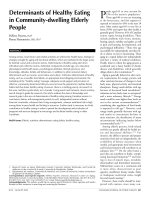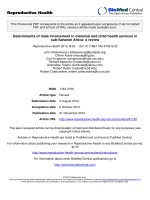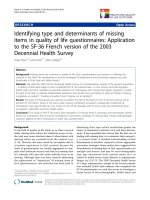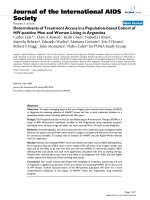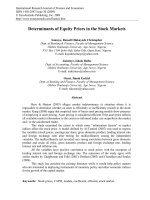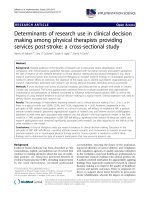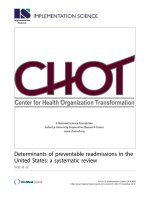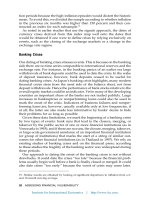Determinants of Currency crises in Emerging economies in 1996-2005 An Early Warning System Approach
Bạn đang xem bản rút gọn của tài liệu. Xem và tải ngay bản đầy đủ của tài liệu tại đây (1.68 MB, 52 trang )
UNIVERSITY
OF
ECONOMICS
HO
CHI
MINH CITY
VIETNAM
INSTITUTE
OF
SOCIAL STUDIES
THE
HAGUE
THE
NETHERLANDS
VIETNAM-
NETHERLANDS
PROGRAMME
FOR
M.A
IN
DEVELOPMENT ECONOMICS
Determinants
of
currency
crises in
emerging economies in 1996-2005:
An
Early
Warning
System
approach
A thesis submitted in
partial
fulfillment
of
the requirements
for the degree
of
Master
of
Arts in Development Economics
By
. ' ,
Trtrang
Hong
Tuan
Thesis supervisor:
Dr.
Vii
Thanh
Ttr Anh
•
•
BQ
GIAO
DVC
FJAO
TAO
TRUONG
HQC
KINH
TE
TP.HCM
THliVIEN
•
r-
Ho
Chi
Minh
city,
October
2009
Certification
I declare that the thesis hereby submitted for the Master degree at the Vietnam-Netherlands
Programme for M.A in Development Economics is
my
own work and has not been previously
submitted by me at another university for any degree. I cede copyright
of
the thesis in favor
of
the Vietnam- Netherlands project for M.A programme in Development Economics.
Ho Chi Minh City,
October 2009
Truong H6ng
TuAn.
Page 2
of
52
Abstract
Theories
of
currency crisis consisted
of
4 generations
of
models suggest that economic and
institutional variables can be employed in early warning system models to predict currency
crisis for the purpose
of
prevention policy. This study incorporates 5 variables from Berg and
Pattillo (1999b) model (Real exchange rate overvaluation, Foreign reserves loss, Export
growth, Current account deficit, Short-term external debt/Foreign reserves) and additional
Domestic credit growth, 6 institutional variables adopted from Worldwide Governance
Indicators (Kaumann et al.,
2008) (Voice and Accountability, Political Stability and Absence
of
Violence, Government Effectiveness, Regulatory Quality, Rule
of
Law, Control
of
Corruption) into a simple logit model with dataset
of
15
emerging market economies
in
the
period
1996:01-2005:09. The new finding
is
the high statistical significance
of
the variable
'Voice and Accountability' (represents freedom
of
speech, free media and ability to
participate
in
selecting government
of
a country citizen) on reducing probability
of
currency
crisis. 'Regulatory Quality' (measures government ability to implement efficient policies
promoting private sector development) also shows its statistical significance at a lower level
in the model. This study also reconfirms other studies that Domestic credit growth and
Current account deficit precede currency crisis.
Page 3
of
52
TABLE OF CONTENTS
Certification
Abstract
Table
of
Contents
Chapter 1 Introduction
Chapter 2 Theories
of
currency crises - A brief review
of
the literature
2
3
4
5
7
Chapter 3 Typical early warning systems and empirical currency crisis models -
A brief review
of
the literature
18
Chapter 4 Methodological issues - Empirical framework 27
Chapter 5 Empirical results 36
Chapter 6
Policy implications and conclusion 40
Notes 42
References 42
Appendix 1 Specification
of
05
empirical currency crisis models
45
,
Appendix 2 Logit regression results by Eviews (Probability
of
currency crisis) 4 7
Appendix 3 Robustness test
of
the result by running logit regression on regions 50
Page 4
of
52
Chapter 1
Introduction
1.1 Statement
of
the Problem
On the way to development, currency crises are very costly for emerging economies.
Currency crises can lead to banking crises, loss
of
GDP, high unemployment rate and loss
of
development momentum. In the Asian crisis in 1997-98, Thailand lost 10.5%
of
GDP,
Indonesia 13.1%
& Malaysia 7.4%.
In May
2008, Morgan Stanley issued a report on Vietnam named "Beyond the tipping point",
comparing Vietnam then with Thailand in 1997 and warning a 38% -55% depreciation
of
VND against USD in the next
12
months.
In June 2008, State bank
of
Vietnam widened trading band for foreign exchange (USD) from
1%
to 2%. In November 2008, it raised the band to 3% and in March 2009 to 5%. Domestic
credit growth rate is
50% in 2007, 34% in 2008 and estimated 30% in 2009 by Economist
Intelligence Unit.
After the booming in stock and real estate market in
2007 with capital inflow mainly for
portfolio investment, a crash
of
more than 70% in stock market broke out in 2008 against its
peak in October
2007. Capital inflow and export shrink, larger current account deficit (13.6%
in
2008) is putting pressure on the peg regime
of
VND to USD.
It
seems that the scenario
of
Asian crisis repeats in Vietnam.
Unlike Asian crisis countries
of
crony capitalism, Vietnam's relationship-based system has
even weaker institutions.
So
do institutions play any role in setting stage for a currency crisis?
Now
is
October 2009. Fortunately, the Morgan Stanley's forecast failed, but whether the
Vietnam currency crisis is coming soon? Thus, currency crisis is a burning issue in Vietnam
for the time being.
1.2 Objective
of
the Research
Page 5
of
52
Vietnam
is
an emerging market economy. Understanding what caused currency crises
in
other
emerging market economies in recent years would be a good reference for further
comprehensive researches on what Vietnam should
do
to prevent its own currency crisis.
1.3 Research Questions
This study aims to answer the following questions:
1.
What are the key determinants
of
currency crises in emerging economies in the period
1996-2005 in the light
of
early warning system approach? (especially, current account
deficit, domestic credit growth and institutional factors)
2. What are the policy implications to prevent a currency crisis?
1.4 Research Methodology
Based on theories, empirical models
of
currency crises and available variables/data,
regression with logit model is carried out to recognize the determinants
of
currency crisis. The
statistic software Eview
4.1
is employed in this study.
1.5 Scope
of
the Research
Based on availability
of
data
of
institutions and review
of
recent history
of
currency crises in
emerging market economies,
15
economies are selected and the period
of
study is limited in
1996-2005.
15
economies are: Argentina, Brazil, Colombia, Czech, Ecuador, India, Indonesia,
Korea, Malaysia, Philippines, Russia, Slovakia, South Africa, Thailand and Turkey.
1.6 Organization
of
the Research
The first chapter
of
this study hereby presents introduction
of
the issue. The second chapter
will look through theories
of
currency crisis. The third introduces some typical early warning
systems (EWS) and empirical currency crisis models employed at IMF, Goldman Sachs and
in a few academic studies. The fourth mentions methodology for designing a EWS model
including variables
of
domestic credit growth and institutions. The fifth represents merits
of
the focused variables in the model and the sixth delivers policy implications and concludes.
Page 6
of
52
Chapter 2
Theories
of
currency crises - A brief review
of
the literature
In the literature
of
financial crises, there are banking crises, (sovereign) debt crisis and
currency crises. Banking crises are recognized
as
the insolvency
of
the banking system that
occurs with high ratio
of
non-performing loan to assets. Demirguc-Kunt and Detragiache
(1997) considered one
of
event or combination
of
the following
as
banking crisis: (1)
nonperforming assets/total assets ratio in the banking system exceeds 1
0%;
(2) the cost
of
rescue at least
2%
of
GDP; (3) large scale nationalization
of
banks; and (4) extensive bank
runs or other emergency measures executed by the government. Debt crisis
is
defined as a
national government fails
to
meet a principal or interest payment on the due date (Reinhart
and Rogoff, 2008). This study focuses on currency crises only.
This chapter consists
of
2 parts. Part 1 presents the identification
of
a currency crisis, part 2
reviews 4 generations
of
currency crisis models.
What cause a currency crisis? It
is
an exciting question since the collapse to the Breton Wood
system. Especially, the heavy costs
of
currency crisis
in
Mexico, Asia, Russia, Argentina
provoke attention
of
several economists.
2.1 Identifying currency crises
An abrupt drop
in
a country currency value
is
regarded
as
currency crisis.
It
is
called 'crisis'
because it bring about negative economic effects. They includes shrink
in
GDP, investment
and job loss, banking and business failures, inflation. Currency crisis can be brought about by
currency speculators or government action, or a mix
of
both.
The ideal way to define a currency crisis
is
as
Bussiere and Fratzscher (2002) that incorporate
moves in exchange rate, interest rate and foreign reserves (initially set out by Girton and
Roper, 1977). They identified a crisis
as
the exchange market pressure (EMP)
of
a specific
country exceeds its mean by 2 standard deviations. EMP
is
constructed
as
a weighted average
of
the change
of
the real effective exchange rate (RER), the change in the real interest rate (r)
and the change in foreign exchange reserves (res). Real values are considered to avoid
different inflation rate across countries. Interest rate
is
involved in case the central bank
defends the domestic currency by increasing its interest rate.
Page 7
of
52
The EMPi,t for defining a currency crisis for each country i and period t in formula
is
as
follows:
_ . ( RERi.t
RERi.t-'i)
(.
_ , ) _ ( resi.r-
resi,1-l
J
-
mRER
+mr
li.r
lu-1
RE/1.
t-
1
· res.
_,
"'"i. .
!.}
•
The weights ffiRER, ffir and ffires are computed
as
the inverse
of
the variance
of
each variable for
itself
so
as
to give a larger weight to the variables with less volatility.
Due to lack
of
data, most
of
the cases currency crisis
is
defined with changes in exchange rate
and foreign reserves only like Kaminsky et
al.
( 1998) (KLR) with a little bit difference in the
threshold
of
number
of
standard deviations. KLR model recognized a crisis
as
EMP goes
beyond its mean by 3 standard deviations.
In another simple way, Frankel and Rose (1996) defined a currency crisis
as
a depreciation
of
the nominal exchange rate
by
at least 25% that also exceeds the previous year's depreciation
by at least 1
0%. Thus, they did not consider speculative attacks failed
by
government
intervention via selling foreign reserves as a currency crisis.
The theories
of
currency crisis have developed over the time. It seems that after a series
of
currency crises occurred, a new-generation crisis model emerges. A brief review
of
currency
crisis literature can trace out 4 generations
of
currency crisis model.
2.2
Four
generations
of
currency crisis models
The
first generation crisis models
The first generation crisis model
is
firstly presented by Krugman (1979). In a small open
economy, government would defend the fixed exchange rate regime with limited foreign
reserves. Perfect foresight private investors hold asset portfolio in two kinds
of
assets:
domestic and foreign currency.
In an attempt to maintain the fixed rate, government has to
sell out reserves until it
is
exhausted. Government finances its budget deficit by printing
money that increases money supply.
Page 8
of
52
The model derives that
as
long as there
is
budget deficit and inflation, investors change the
composition
of
their asset portfolio by increasing the proportion
of
foreign exchange,
reducing the proportion
of
domestic currency. Government has to run down its reserves to
retain the fixed rate on the way to finance its budget deficit. Exhaustion
of
reserves pushes
government to abandon the pegging. Such expectation makes investors advance the date
of
their speculative attacks, the leading speculators sell domestic money even earlier and
so
on,
reserves run out faster and currency crisis breaks out.
The model seems to have highly simplified assumptions on two asset portfolio holding, the
tools government uses to intervene in foreign exchange market, only selling reserves, perfect
foresight speculators, the time
of
crisis
is
unclearly identified.
Flood and Garber (1984) refined Krugman (1979)
model by developing it into 2 models. The
first one
is
a perfect-foresight, continuous-time model that relaxes two-asset portfolio
to
4-
asset portfolio (included domestic and foreign bond) and adding domestic credit into the
model. They found out the exact timing
of
the peg collapse, and timing has a positive
relationship with the size
of
reserves and a negative one with the domestic credit growth rate.
The first model also shows that currency crisis can emerge under arbitrary speculative
behavior
of
investors but they assumed that this effect is zero for simplifying analysis. The
second model
is
a discrete time, stochastic one (relax assumption
of
perfect foresight) that
incorporate uncertainty to study the forward exchange rate
of
a peg regime as a response to
reality that forward rate may exceed the fixed rate for long period
of
time. Using the concept
the shadow exchange rate, the rate that would prevail after the speculative attack, the second
model yields an endogenous probability distribution over the crisis time and produces a
forward exchange rate that
is
greater than the fixed rate (capture the real world).
The policy conflict
in
above-mentioned models
is
the financing fiscal deficit and retaining
fixed exchange rate regime. Dooley (1997) proposed
an
insurance model, in which the policy
conflict is the desire
of
a credit-constrained government
to
hold reserve assets
as
a form
of
self-insurance against shocks to national consumption and the government's desire to insure
financial liabilities
of
residents. The first objective
is
pursued by accumulation
of
foreign
reserves while the second objective depletes
it.
Once the domestic yield
is
greater relative to
international returns, it generates a private gross capital inflow. Capital inflow increases
to
an
extent that there
is
not enough foreign reserves to insure deposits, extra deposits have risk
exposure. This gap will ignite a speculative attack
to
minimize loss that runs
up
to crisis.
Page 9
of
52
Dooley model offers a capital inflow/currency crisis follow view, that not budget deficit,
money supply or higher international interest rate
is
blamed for currency crisis.
The first generation models explained well the crisis
of
Latin America countries in the 1980s
that have macroeconomic fundamental problems such
as
fiscal deficit, hyperinflation, foreign
loan, current account deficit, capital flight.
The first generation models suggest that macroeconomic fundamentals are the causes
of
currency crises. Variables used
in
early warning systems could be budget deficit, money
supply, domestic credit, current account deficit, international interest rates, capital
inflow/outflow (capital control).
In
the early 1990s, there were several currency crises, such
as
the European Monetary System
crisis
of
1992-93, that could not be explained by the first generation models. Europe countries
at that time had sound macroeconomic fundamentals, but currency crises still occurred. The
currency crisis model then evolved to confront the new reality. The second generation came
out.
The second generation crisis models
The second generation crisis models, initially developed by Obstfeld (1994, 1996): self-
fulfilling and contagious crises.
The first generation models constrained government's tools
in
intervening foreign exchange
market to selling limited reserves only. The second· generation models relax this point, let
foreign reserves can
be
freely borrowed in the world capital market, subject only to the
government's intertemporal budget constraint.
In
a setting
of
purposeful reaction by the government, self-fulfilling crisis
is
taken into
account. Speculative anticipations depend on government responses, which subject to how
price changes, that in turn are driven by expectations. This dynamic circle suggests a potential
for crises that would not have occurred, but that
do
because the market players expect them
to. They are self-fulfilling crises.
Obstfeld (1994) raised a question: Why does the government like to abandon the fixed rate?
He described 2 models
in
the paper to answer.
It
is
because government debt denominated in
domestic currency and unemployment problem.
In one model, he mentioned the role
of
Page
10
of
52
nominal interest rate. Devaluation expectations feed into high nominal interest rate that
pushes government further to give
up
the peg would have been viable under reverse private
expectations. Maturity structure
of
the government's domestic obligations and the currency
composition
of
the overall public debt would decide the effect
of
interest rate
in
devaluation.
Large portion
of
debt burden denominated in domestic currency, higher nominal interest rate
will lead to higher devaluation to lessen the government debt burden.
Perfect foresighted
speculators would try to get out
of
the domestic currency ahead
of
that devaluation.
In
another
model, expectations feed into wages and competitiveness, raising unemployment. The country
suffers from unemployment/competitiveness problem due to demand shock and/or pre-set
nominal wage, would like to abandon the fixed rate. Negative expectation
of
government's
willingness to tolerate unemployment can trigger a devaluation that would not have occurred
under opposite. expectations.
In
contrast to the first generation models, the loss
of
reserves
is
not the factor triggering currency crisis.
The models propose that a speculative attack can occur even with the absence
of
poor
macroeconomic conditions in the pre-crisis time. Currency crisis can result from self-fulfilling
attack in which speculative anticipations and herding behavior play a role.
Once unemployment rate
is
on upward trend and government policy is
to
maintain a fixed
exchange rate. Speculators can perceive that high political cost
of
the maintaining
of
the fixed
exchange rate facing the future rising unemployment. They recognize the devaluation
is
likely. Even they don't know when, they start selling domestic currency now. Herding
behavior sets in and full-scale speculative attack breaks out even before unemployment
becomes a problem.
Eichengreen et al. (1996) show that contagion takes its effect once the devaluation
of
a
country's currency may reduce its trading partners' competitiveness enough to make their
currencies subject
to
devaluation too. They pose hypothesis that there are 2 channels for
contagion taking effect. Trade linkage between 2 countries can motivate one country to
devalue its currency to increase its international competitiveness one the other country
devalued previously. Based on the current and prospective international competitiveness
of
the countries concerned, speculators ignite attacks. The similar macroeconomic conditions
across countries also are foundations for advancing speculative attacks. Using a panel
of
quarterly data for
20
industrial countries for the period 1959-1993 to test for contagious
currency crises, they find evidence
of
contagion. Contagion appears to spread
to
countries
which have close international trade linkages rather than to countries in similar
macroeconomic conditions.
Page
11
of52
Calvo (1995) suggest that the basic cause
of
a currency crisis may be investors' behavior.
Risk averse investors invest
in
several countries. Financial diversification and lender's
information have an interesting relationship. Investors with highly diversified portfolio have
lower incentives to learn about individual countries than investors with few diversification
opportunities. Diversification encourages ignorance and, in that context, rumors could result
in massive capital flows from a country. So investment into or away from a country is highly
sensitive to news in a world
of
highly diversified investors. Diversification magnifies herding
behavior by making investors more sensitive to rumors.
If
the composition
of
portfolio
is
mainly short-term capital, the capital flight may be quick, causing an abrupt crisis.
If
self-fulfilling crises are a real possibility, what stimulates them? The answer is that
anything could in principle be the driver. They would be expected unemployment, public
debt, international competitiveness in trade, political factors This rationale gives a spacy
room for empirical early warning system models in predicting crises.
Second-generation models can explain the European Exchange Rate Mechanism (ERM) crisis
in the
1990s. These crises didn't emerge by the poor macroeconomic fundamentals but by
inconsistent policy and political events. In Europe, the crises occurred in Britain, Italy, France
because
of
the inconsistent policy with their committed peg to the German mark. Retaining
peg to German mark, they have to maintain high interest rate on local currency and face slow
growth, gloomy export and increasing unemployment. Speculators such as Soros recognized
the tradeoff government confronts and expected the government under political pressure will
give up the peg. Their speculative attacks succeeded.
In fact, behind the scene
of
claimed sound macroeconomic fundamentals, potential economic
instability laying aside in Europe incites speculative attacks. Macroeconomic fundamentals
actually still play their role to a certain extent in the second generation model
of
crisis.
In 1997-1998, new reality
of
crisis emerged again that requires currency crisis model to
continue to evolve to deal with new generation
of
crisis.
The third generation crisis models
The Asian crisis
of
1997-98 led to the third generation models: twin crisis, a mix
of
banking
and currency crisis. In fact, Velasco ( 1987) proposed models
of
interaction between banking
problems and currency crisis. Credit boom, bad debt, government spending on bail out
Page
12
of
52
(budget shrinks) and stop
of
capital inflow all lead the way to abandonment
of
fixed exchange
rate regime. Velasco (1987) represented experiences in
South America with these features.
Their models received little attention until the Asian crisis in 1997 broke out.
What Velasco did is to extend Krugman model to a situation where foreign assets pay interest,
including the presence
of
banks to find out the dynamics
of
banking crisis and currency crisis.
There is an asymmetry in the liquidity and riskiness
of
bank assets and liabilities. A bank
usually guarantees the nominal value
of
the deposits it accepts while allocating the
money to investments with a variable return. Normally, bank deposits are highly liquid,
while bank investments are low liquid and long-term. It takes time and cost to liquidate bank
investments. There is an assumption that all bank deposits are implicitly or explicitly
guaranteed by the government. Domestic and foreign depositors/lenders believe in the
government umbrella, still put money into the banking system in spite
of
banking operation
loss. Banks play the
Ponzi game until the problem become serious. Government steps in to
help, depletes its budget and foreign reserves. Currency crisis
of
Krugman type eventually
arrived here.
Using monthly data
of
20 countries for the period 1970-mid1995, Kaminsky & Reinhart
(1999) also found that problems in the banking sector typically emerge before a currency
crisis. The currency crisis then worsens the banking crisis, making a vicious spiral. Financial
liberalization often precedes banking crises. The progression
of
these events suggests that
crises occur as the economy starts to enter a recession, following a boom in economic activity
that is fueled by credit, capital inflows, associated with an overvalued currency.
Compared to first and second generation models, Asian crisis appears to be differently.
Macroeconomic fundamentals are sound with· high
GDP growth rates, low unemployment
rate, low inflation, low budget deficits, manageable current account deficits, strong capital
inflows and prevailed political stability. However, inside
the
bright picture, there are
problems in the banking sector - bad loans from domestic borrowers and unhedged, short-
term borrowing from foreign banks. The bad loan accumulation is the consequence
of
over
lending. Krugman (1998) described a moral hazard/asset bubble view. There was a boom-bust
cycle in the asset markets preceding the Asian currency crisis. Prices
of
stock and land were
soaring and plunging before the crisis. Besides, moral hazard involved
as
strong political
relations between government and finance companies/banks/corporations (crony capitalism)
suggested implicit guarantees from government for lenders and depositors. The lenders
become much less prudent in lending to inefficient investment projects because
of
expectation
on government bailout.
Page
13
of52
Third generation model implies an additional set
of
variables related to financial liberalization
and banking problem for early warning system. Name a few as: Real interest rate, lending-
deposit rate ratio, M2/reserves, bank deposit, non-performing loan.
Recently, we faced the re-emergence
of
institutional economics (economics Nobel prize 2009
is an award for institutional economics) that pays more attention to the foundations for market
functioning that shed new light on currency crises.
The
fourth generation crisis models
Behind the scene
of
phenomena like government budget and current account deficits,
hyperinflation, self-fulfilling attacks, herding behavior, excessive lending, deeper questions
should be raised. What institutional factors set conditions for these pictures? In these models,
institutional factors are incorporated and emphasized with a wide range: law framework,
property right, enforcement
of
contract, financial regulations, bureaucratic quality,
government stability, democracy and corruption
Breuer (2004) coined these models as the
fourth
generation.
This institutional focus has foundations on the theory
of
relationship between institutions and
economic growth/crisis presented by Acemoglu et al.
(2002), Rodrik et al. (2002), Fukuyama
(1995), Sen (1999), Johnson et al.
(2000) and asymmetric information problem in financial
market by and Mishkin (1996,
2001) as typical ones among several other authors.
A defmition
of
institutions is helpful here. What are institutions? By words ofDouglass North
(1993) in his Nobel prize lecture:
"Institutions are the humanly devised constraints that structure human interaction.
They are made up
of
formal constraints (rules, laws, constitutions), informal
constraints (norms
of
behavior, conventions, and self imposed codes
of
conduct), and
their enforcement characteristics. Together they define the incentive structure
of
societies and specifically economies."
Incentives and expectations play a vital role in the financial world that
is
infamous for
uncertainty. Institutions form the foundations and facilitate a well-functioning currency and
banking system. That's reason why the fourth generation models
of
currency crisis
incorporate institutional variables.
Page
14
of
52
Fukuyama (1995) proposed the role
of
trust in society that lowers administration cost,
increases institutional reliability and promotes large and efficient organizations. Low trust
society usually has corruption and trade with influences and tends to maintain small and
inefficient organizations. Trust should promote economic development. It
is
vital for financial
market whether investors have trust or loss
of
confidence in them.
Sen (1999) presented concisely some
of
his best-known work on famines. They are usually
occurred by a lack
of
purchasing power or entitlements, not by food shortage. He claimed that
large-scale famines never happened
in
a democracy. They can only happen in authoritarian
regimes lacking openness
of
information and transparency. His analysis inspired similar
approach
to
the Asian crisis in 1997.
Johnson et al.
(2000) proved that the effectiveness
of
protection for minority shareholders
explain the extent
of
declines
in
exchange rate depreciation and stock market better than
standard macroeconomic measures
do.
They modelized the conflict
of
interest between
insiders (managers) and outsiders (equity owners). Weaker corporate governance rules and a
weaker legal system reduce the cost
of
stealing (expropriation)
of
managers. The manager
compares the marginal cost and marginal benefit
of
stealing for their reaction. For a given rate
of
return,
if
the manager invests less their own money, they have more incentives to steal.
However,
if
the manager has more shares in the firm, an increase in the return on investment
persuades
himto
invest more into the project and, therefore, to steal less. On the other hand,
if
the manager owns more
of
the firm, but the return on investment reduces, then
he
steals more.
The stealing
of
manager shrinks value
of
firm. Less value
of
the firm, less confidence
of
foreign and domestic investors stays
in
the stock market. Loss
of
confidence in the stock
market triggers capital outflow or stop
of
capital inflow. The capital outflow affects foreign
exchange market, ignites currency crisis.
In
order to study 27 emerging markets in the end
of
1996
to
January 1999, Johnson et al. employed data measure institutional variable such
as:
shareholder protection, credit right, accounting standards, enforceability
of
contracts Gudicial
efficiency, corruption, rule
of
law, corporate governance); economic variable like: fiscal and
monetary policy, current account and reserves. Running linear regression
of
these institutional
and economic variables on exchange rate and then stock price, they found that the regression
results support their theory. Lower quality
of
shareholder protection and enforceability
of
contract have high statistical significance and influence in explaining the depreciation
of
domestic currency and decrease in stock price in emerging markets.
Page
15
of
52
Acemoglu et
al.
(2002) observed that countries pursuing poor macroeconomic policies also
have weak institutions, including political institutions that
do
not constrain politicians, weak
property rights for investors, widespread corruption, and a high degree
of
political instability.
They proposed that macroeconomic policies are more likely to be symptoms
of
underlying
institutional problems rather than the main causes
of
economic volatility, weak institutions
can cause volatility through a number
of
macroeconomic and microeconomic channels.
Mishkin ( 1996,
200
1)
approached financial crises in the light
of
asymmetric information with
the moral hazard problem. Emerging market economies such
as
Mexico, Ecuador, East Asian
crisis countries and Russian are well-known for weak financial regulations and supervision.
When financial liberalization facilitate international capital inflow and opportunities to take
more risky lending, these weak regulatory/supervisory system could not limit the moral
hazard problem created by the government safety net. Once government has signals offering
bailouts
to
protect banks & corporations, excessive risk taking
is
one result, increasing the
probability
of
financial crisis embracing banking crisis and currency crisis. Mishkin also
proposed
12
areas
of
policy to prevent financial crisis:
1.
Prudential supervision,
2.
Accounting and disclosures requirements, 3. Legal and judicial systems,
4.
Market based
disciplines,
5.
Entry
of
foreign banks,
6.
Capital control,
7.
Reduction
of
control
of
state-
owned financial institutions,
8.
Restrictions on foreign-dominated debts,
9.
Elimination
of
too-big-too-fail
in
the corporate sectors,
10.
Sequencing
of
the financial liberalization,
11.
Monetary policy and price stability,
12.
Exchange rate regimes and foreign exchange
reserves. From this list, we can see some institutional factors that cause financial crisis.
Rajan,
R.
G.
and Zingales,
L.
(1998) looked through the Asian crisis, pointed out that
relationship-based systems (that are inefficient and corrupt) tend
to
attract short-term external
capital inflows that make them excessively prone to shocks. A relationship-based system
distorts the price system and the signals it provides. As a result, it can misallocate capital.
Majority
of
external capital inflow
is
typically from foreign investors that have little
contractual rights or power
in
a relationship system. They understand the potential for
misallocation and keep their claims short term for easy withdrawing.
Due
to
the definition
of
institutions, they may include factors
of
law system, legal practices,
financial regulations, politics, customs, culture. Thus the fourth generation crisis models spare
large room for the choice
of
variables usable
in
early warning system for currency crises.
The US crisis 2008: a new crisis generation or an old story?
Page
16
of
52
The existing crisis in the
US
is in fact a banking crisis caused by excessive lending on sub-
prime mortgages (Ellis,
2008). The sub-prime mortgages are cut into pieces in securitization
process and the risk become opaque, then are sold out, spread in the
US
and over the world.
Like the scenario is described in the third crisis generation (twin crisis), banking crisis come
first, government implements giant bailouts
of
banks/corporations and then currency crisis
follows. There are holes in financial regulations in the
US financial system that promotes such
excessive risk lending (no job-no problem housing loans). Thus, the fourth generation factors
can also be used to explain the
US crisis. Although FED's newly-issued treasury bonds (for
bailouts) are supported by huge international reserves from China, the
US dollar is being
depreciated against other main currencies (EUR,
GBP, AUD). So we can consider the
US
crisis
is
kind
of
third and fourth generation combination.
Theories on the causes
of
currency crises set foundation for several early warning system and
empirical currency crisis models coming out. The four generations
of
currency crisis models
suggest what variables should be employed in empirical early warning system and currency
crisis models. While the first and the third generation models point out the specific economic
variable such as budget deficit, current account deficit, money supply, capital flow, bad debts
as indicators
of
currency crisis, the second and the fourth generation give more room for
choices ofvariables. It is because expectations can be based on a wide range
of
indicators and
institutions involve a lot
of
factors related to laws, politics, culture.
Page
17
of
52
Chapter 3
Typical early warning systems and empirical currency crisis
models - A brief review
of
the literature
The Mexican and Asian crises took the international community somewhat by surprise and
since then raised the attention on methods that could forecast crises
of
highly vulnerable
countries
in
the timely manner.
Several early warning systems (EWS) empirical currency crisis models have been. designed
and some
of
them are being used by IMF and private financial institutions like Goldman
Sachs for policy and speculative purposes. The Table 1 hereunder summarizes the main
features
of
typical EWSs, including EWSs used in IMF like Kaminsky et
al.
( 1998), Berg and
Pattillo (1999b),
in
Goldman Sach like GS-WATCH (Ades et al., 1998), and EWSs presented
in other academic studies like Peltonen (2006), Shimpalee and Breuer (2006), Leblang and
Satyanath
(2008).
3.1 Signal approach
Kaminsky et al. ( 1998) (KLR) proposed observation
of
15
indicators that give warning
signals prior to a crisis. KLR's crisis definition is previously mentioned
in
chapter
2.
of
this
study (Theories
of
currency crisis). KLR selected
15
indicators based on prior theories and on
the monthly data available.
15
variables are listed below:
1.
Real exchange rate deviation
2.
Banking crisis
3. Export
4.
Stock prices
5.
Growth rate
of
M2/ international reserves
6.
Output
7.
'Excess' real
M1
balances (Residual from regression
of
real
M1
on real GDP,
inflation, and a deterministic trend)
8.
International reserves
9.
M2
multiplier
10.
Domestic credit/GDP
11.
Real interest rate
Page
18
of
52
12. Terms
of
trade
13. [Real interest differential
14. Imports
15. Bank deposits
16. Lending rate/deposit rate]
An
indicator gives out a signal whenever it moves beyond a specific threshold. Thresholds are
defmed in relation to percentiles
of
the distribution·
of
observations
of
the indicator. An
optimal threshold for a given predictor, such as export loss, might be 70, for example, that is
uniform across countries, the corresponding country-specific thresholds would likely differ
(for example
20% in a country, 30% in another). The performance
of
each indicator is
considered in the following matrix:
Table 3.1: Matrix
of
measuring performance
of
indicators
Crisis
No crisis
Signal was issued
No signal was issued
(within 24 months)
A
(within 24 months)
B
c
D
Source: (Kaminsky et al., 1998)
In
this matrix, A represents the number
of
months in which the indicator issued a good signal,
B is the number
of
months in which the indicator issued a bad signal or
'noise,' C is the number
of
months in which the indicator failed to issue a signal which would
have been a good signal, and D is the number
of
months in which the indicator did not issue a
signal that would· have been a bad signal. The optimal percentile threshold is the one that
minimizes the bad signal to good signal ratio [(B/(B+D)]/[A/(A+C)]. Four indicators (Real
interest differential, Imports, Bank deposits, Lending rate/deposit rate) that produce excessive
noise are eliminated from the
KLR
model.
As
described by Berg and Pattillo (1999a), Kaminsky
1
later developed a single composite
indicator
of
crisis that is computed as weighted sum
of
the indicators, where each indicator is
weighted by the inverse
of
its bad signal/good signal ratio.
Then a probability
of
crisis for each value
of
the composite index
is
calculated by the number
of
months having a given value
of
the index is followed
by
a crisis within 24 months.
Page
19
of
52
Because
of
the shortcoming
of
signal approach in testing statistical significance
of
each
indicator, most
of
the EWSs are probit/logit based models.
3.2
Probit/Logit approach
Berg and Pattillo (1999a) modified and carried out out-of-sample test for the KLR model to
predict Asian crisis 1997. Berg and Pattillo added 2 additional variables (Current account
deficit/GDP ratio, level ofM2/Reserves) also replaced 5 developed countries in the sample by
8 emerging market countries. Then they transformed KLR's signal approach to probit based
model with
05
variables only (Reserves growth rate, Export growth rate, Real exchange rate
deviation, Current account deficit/GDP and M2/Reserves).
Probit and modified KLR
performed well
in
predicting Asian crisis 1997. However, probit model with 5 variables can
test the statistical significant
of
individual indicators with ease while the KLR model (with
17
variables) can not
do
it.
(Table 3.2)
Berge and Pattillo (1999b)
(BP model) presented a simple probit model over a panel
of
developing countries through
1995
to predict Asian crisis 1997. They found that 5 variables
(Reserves growth rate, Export growth rate, Real exchange rate deviation, Current account
deficit/GDP
& Short-term debt/Reserves)-measured in percentile- performed well
in
forecasting the crisis 1997. They regarded the first 4 variables as first generation ones and
short-term external debt/reserves
as
second generation one. Short-term external debt/Reserves
ratio is used to measure vulnerability to panic, suggested by Radelet and
Sachs (1998). Once
foreign lenders become convinced that other lenders would not roll over their loan, there are
not enough reserves
to
cover the mature loans. Panics tum into self-fulfilling. (Table 3.2)
Goldman
Sach's GS-WATCH model, designed
by
Ades et
al.
(1998),
is
the logit model
employing
09
variables (Table 3.2) included
01
political risk indicator. Like BP model, their
definition
of
crisis involves reserves loss and nominal exchange rate move, but they have
specific thresholds for specific countries by using
Self Exciting Threshold Autoregression
technique (also used to
identifY
recession
in
business cycle literature). Different from BP
model, GS-WATCH incorporates stock prices, real interest rate in
G7
economies, contagion,
credit (to private sector) growth and political risk - a fourth generation variable. For their
purpose
of
private institutional investor, the predicting horizon
is
3 months only. Their
in-
sample test proved their model worked well in predicting currency crisis
in
developing
countries. (Table 3.2)
Page 20
of
52
Peltonen (2006) model identified a currency crisis similarly
to
BP
model but he used the
threshold
of
2 standard deviations beyond the mean
of
the specific country's crisis index. His
choice
of
variables falls
in
a range
of
3 generations, from budget deficit, contagion to, stock
price, real interest rate (Table 3.2). He also used several dummy variables for the world's
regions and for different exchange rate regimes. After testing in-sample and out-of-sample,
Peltonen also claimed that his model did a good predicting work.
3.3 Incorporating institutional variables
Shimpalee and Breuer (2006) extended EWS by adding institutional variables to previous
economic EWSs
in
the literature. They selected 3 models
of
Eichengreen et al. (1995),
Kaminsky and Reinhart (1999), Frankel and Rose (1996) and incorporated
13
institutional
variables into these 3 models. Most oftheinstitutional variables are measured by International
Country Risk Guide. The additional variables are briefly described
as
follows:
1.
Bureaucratic quality: measures the strength and quality
of
civil service and
bureaucrats and their ability to manage political problems without interruption
of
services.
2.
Government stability: captures the government ability to continue its announced
programs and to stay
in
office.
3.
Absence
of
corruption: higher index means less corruption.
4.
Law and order (quality): measures the strength and impartiality
of
the legal system
and popular observance
of
the law.
5.
Absence
of
ethnic Tensions: rooted from racial, nationality, or language division and
gauge. The index measures how intolerant groups might be to compromise. Higher
number indicates lower ethnic tensions.
6.
Absence
of
external conflict: ranges from trade restrictions and embargoes to
geopolitical disputes to incursions, insurgencies, and warfare.
7.
Absence
of
internal conflict: reflects the extent
of
political violence.
8.
Exchange rate regime: dummy variable. Code 1 with fixed exchange rate, and 0
otherwise.
9.
Capital controls: controls on capital account transactions, or restrictions on capital
movements, especially inflows with a
1,
and 0 otherwise.
10.
Central bank independence: level
of
freedom from political pressure. It
is
measured
on a scale between
0 and 1 where 0 stands for the minimum level
of
independence
and 1 for the maximum level.
Page
21
of
52
11.
Deposit insurance: dummy, 1 with explicit deposit insurance protection systems, 0
otherwise.
12.
Financial liberalization: real interest rates are used as a proxy for financial
liberalization because real interest rates are usually lower, or negative, in repressed
financial systems.
13.
Legal origin: dummy. Civil law system are coded
as
1 and common law countries
as
0.
The rationale to include the institutional variables into the EWS model can be traced back to
theories
of
the four generation model
of
currency crisis.
The trial and error process, by dropping a few institutional variables in the 3 models,
suggested that, in most
of
the cases, government stability, absence
of
corruption, law and
order (quality), central bank independence play an important role in currency crises. (Table
3.2)
In
the similar approach
of
Shimpalee and Breuer (2006), Leblang and Satyanath (2008)
employed 3 EWS models
of
Frankel and Rose (1996) (FR model), Kamin et al. (2001) (KSS
model), Bussiere and Fratzscher (2002) (BF model) and associated additional political
variables into them. Most
of
the political variables are measured by the World bank's
Database
of
Political Institutions (Beck et al., 2003), except for the Democracy indicator
measured by Adam
Przeworski and his colleagues (Alvarez et al., 2000). The following are
the extra political variables: (Table 3.2)
1.
Government turnover: extent
of
turnover
of
a government's key decision makers
in
any one year.
2.
Unified/Divided government: A divided government
is
defined as the party
of
the
chief executive does not control the legislative, then this dummy take the value
of
1,
otherwise,
0.
3. Democracy: a dummy represents the absence/presence
of
a government actually
relinquishing office following an election.
4.
Number
of
checks and balance: the number
of
actors whose permission
is
required to
change policy from the status quo.
5.
Political polarization: captures the polarization level
of
zero
as
elections are not
competitive, or
if
the chief executive's party has an absolute majority in the
legislature.
Page 22
of
52
Leblang and Satyanath (2008) added 2 variables (Government turnover, Unified/Divided
government) into FR model,
KSS and BF models first, then Democracy, Checks and balance,
Polarization.
For the FR model, Turnover and Unified government proved their correct signs and statistical
significance. A shift from unified to divided government or an increase in government
turnover does increase the probability
of
currency crisis.
In
KSS and BF models, coefficients for unified government and government turnover are
correctly signed. Out
of
which, government turnover is statistically significant
in
KSS model
and vice versa
in
BF model. For the out-of-sample test, all 3 modified models claim its
improvement over 3 original models in predicting crises.
The FR model with additional Turnover and Unified government is considered as 'core FR
model'. Robustness tests are done on the core FR model by adding in turn each
of
3 other
variables (Democracy, Checks and balance, Polarization) and Country and decade dummies.
Turnover and Unified government still proves correct sign and high statistical significance.
Democracy, Checks and balance and Polarization show low significance although Democracy
& Checks have correct sign.
(Refer to the Appendix 1 for specification
of
05
currency crisis models
of
Eichengreen et
al.
(1995), Frankel and Rose (1996), Kaminsky and Reinhart (1999), Kamin et
al.
(2001) and
Bussiere and Fratzscher
(2002).)
Page
23
of
52
Table 3.2
Specification
of
typical
Early
Warning
Systems
and
empirical
currency
crisis models
Crisis
definition
Predict time
horizon
Method
Dataset time
Countries
involved
Variables
Kaminsky
et
al. (KLR, 1998) (IMF) Berg
and
Pattillo (1999b) (IMF)
Weighted average
of
one-month
changes in exchange rate minus one-
month changes in reserves that
exceed country specific mean and 3
standard deviations.
24 months
Signal approach.
An indicator gives out a signal
whenever it moves beyond a specific
threshold.
1970-1995
15
developing and 5 industrial
countries
Real exchange rate deviation
Banking crisis
Export
Stock prices
Growth rate
of
M2/ international
reserves
Output
'Excess' real
M1
balances
International reserves
M2 multiplier
Domestic credit/GDP
Real interest rate
Terms
oftrade
(Real interest differential
Imports
Bank deposits
Lending rate/deposit rate)
Same as KRL (1998)
24 months
Probit regression on pooled data
measured in percentiles.
1986-1995
23
developing countries
Real exchange rate deviation
Current account
Reserves loss
Export loss
Short-term debt/Reserves
Page 24
of
52
Table
1 (cont.)
Specification
of
typical
Early
Warning
Systems
and
empirical
currency
crisis models
Ades
et
al. (1998) (Goldman Sachs) Peltonen (2006)
Crisis defmition Weighted average
of
three-month Weighted average
of
one-month changes in
changes in the trade-weighted real exchange rate minus one-month changes in
exchange rate minus three-month changes reserves that exceed country specific mean and 2
in reserves that exceed country specific standard deviations.
Predict time
horizon.
Method
Dataset time
Countries
involved
Variables
threshold found in autoregression
(SET AR:
Self
Exciting Threshold
Autoregression, a technique used in the
business cycle literature to identify
recession)
03
months
03
months
Logit regression with variables measured Probit regression on pooled data.
as
0/1
indicators based on threshold found
in autoregression and dummies (SET AR:
Self Exciting Threshold Autoregression)
and
as
continuous value.
1983-1998
27 developing countries
Real exchange rate deviation
Export growth
Credit growth
Reserves/M2 (level)
Financing requirement (current account
deficit plus gross external amortization
payments)
Stock market price
Global liquidity (real interest rate in G-7
economies)
Contagion
Political risk
1980-2001
24 developing countries
Government budget balance/GDP
Current account/GDP
Under/Overvalue
of
Real Effective
Exchange Rate
Real interest rate
RealGDP
Real domestic credit grow
Broad money/Foreign reserves
Stock market index
Dummy for hyperinflation
Dummy for contagion
Dummy for de facto pegged FX regime
Dummy for de facto crawling pegged FX regime
Dummy for de facto managed float FX regime
Dummy for de facto floating FX regime
Dummy for de facto freely falling FX regime
Dummy for Latin America
Dummy for Europe
Dummy for Asia; Dummy for Africa
Page
25
of
52
